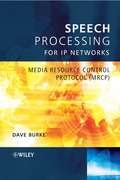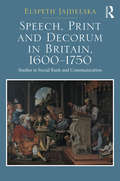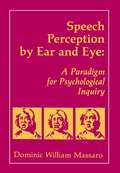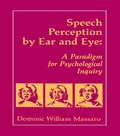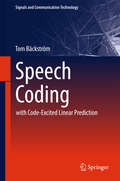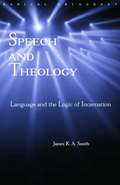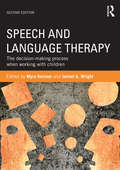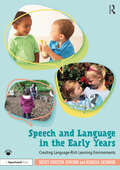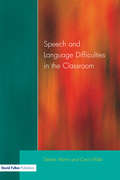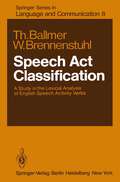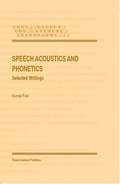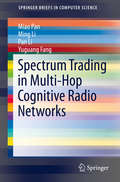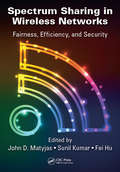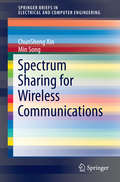- Table View
- List View
Speech Processing for IP Networks: Media Resource Control Protocol (MRCP)
by David BurkeMedia Resource Control Protocol (MRCP) is a new IETF protocol, providing a key enabling technology that eases the integration of speech technologies into network equipment and accelerates their adoption resulting in exciting and compelling interactive services to be delivered over the telephone. MRCP leverages IP telephony and Web technologies such as SIP, HTTP, and XML (Extensible Markup Language) to deliver an open standard, vendor-independent, and versatile interface to speech engines. Speech Processing for IP Networks brings these technologies together into a single volume, giving the reader a solid technical understanding of the principles of MRCP, how it leverages other protocols and specifications for its operation, and how it is applied in modern IP-based telecommunication networks. Focusing on the MRCPv2 standard developed by the IETF SpeechSC Working Group, this book will also provide an overview of its precursor, MRCPv1. Speech Processing for IP Networks: Gives a complete background on the technologies required by MRCP to function, including SIP (Session Initiation Protocol), RTP (Real-time Transport Protocol), and HTTP (Hypertext Transfer Protocol). Covers relevant W3C data representation formats including Speech Synthesis Markup Language (SSML), Speech Recognition Grammar Specification (SRGS), Semantic Interpretation for Speech Recognition (SISR), and Pronunciation Lexicon Specification (PLS). Describes VoiceXML - the leading approach for programming cutting-edge speech applications and a key driver to the development of many of MRCP’s features. Explains advanced topics such as VoiceXML and MRCP interworking. This text will be an invaluable resource for technical managers, product managers, software developers, and technical marketing professionals working for network equipment manufacturers, speech engine vendors, and network operators. Advanced students on computer science and engineering courses will also find this to be a useful guide.
Speech, Print and Decorum in Britain, 1600--1750: Studies in Social Rank and Communication
by Elspeth JajdelskaFilling an important gap in the history of print and reading, Elspeth Jajdelska offers a new account of the changing relationship between speech, rank and writing from 1600 to 1750. Jajdelska draws on anthropological findings to shed light on the different ways that speech was understood to relate to writing across the period, bringing together status and speech, literary and verbal decorum, readership, the material text and performance. Jajdelska's ambitious array of sources includes letters, diaries, paratexts and genres from cookery books to philosophical discourses. She looks at authors ranging from John Donne to Jonathan Swift, alongside the writings of anonymous merchants, apothecaries and romance authors. Jajdelska argues that Renaissance readers were likely to approach written and printed documents less as utterances in their own right and more as representations of past speech or as scripts for future speech. In the latter part of the seventeenth century, however, some readers were treating books as proxies for the author's speech, rather than as representations of it. These adjustments in the way speech and print were understood had implications for changes in decorum as the inhibitions placed on lower-ranking authors in the Renaissance gave way to increasingly open social networks at the start of the eighteenth century. As a result, authors from the lower ranks could now publish on topics formerly reserved for the more privileged. While this apparently egalitarian development did not result in imagined communities that transcended class, readers of all ranks did encounter new models of reading and writing and were empowered to engage legitimately in the gentlemanly criticism that had once been the reserve of the cultural elites. Shortlisted for the European Society for the Study of English (ESSE) book prize 2018
Speech, Print and Decorum in Britain, 1600--1750: Studies in Social Rank and Communication
by Elspeth JajdelskaFilling an important gap in the history of print and reading, Elspeth Jajdelska offers a new account of the changing relationship between speech, rank and writing from 1600 to 1750. Jajdelska draws on anthropological findings to shed light on the different ways that speech was understood to relate to writing across the period, bringing together status and speech, literary and verbal decorum, readership, the material text and performance. Jajdelska's ambitious array of sources includes letters, diaries, paratexts and genres from cookery books to philosophical discourses. She looks at authors ranging from John Donne to Jonathan Swift, alongside the writings of anonymous merchants, apothecaries and romance authors. Jajdelska argues that Renaissance readers were likely to approach written and printed documents less as utterances in their own right and more as representations of past speech or as scripts for future speech. In the latter part of the seventeenth century, however, some readers were treating books as proxies for the author's speech, rather than as representations of it. These adjustments in the way speech and print were understood had implications for changes in decorum as the inhibitions placed on lower-ranking authors in the Renaissance gave way to increasingly open social networks at the start of the eighteenth century. As a result, authors from the lower ranks could now publish on topics formerly reserved for the more privileged. While this apparently egalitarian development did not result in imagined communities that transcended class, readers of all ranks did encounter new models of reading and writing and were empowered to engage legitimately in the gentlemanly criticism that had once been the reserve of the cultural elites. Shortlisted for the European Society for the Study of English (ESSE) book prize 2018
Speech Perception By Ear and Eye: A Paradigm for Psychological Inquiry
by Dominic W. MassaroFirst published in 1987. Routledge is an imprint of Taylor & Francis, an informa company.
Speech Perception By Ear and Eye: A Paradigm for Psychological Inquiry
by Dominic W. MassaroFirst published in 1987. Routledge is an imprint of Taylor & Francis, an informa company.
Speech Perception By Ear and Eye: A Paradigm for Psychological Inquiry
by Dominic W. Massaro Jeffry A. SimpsonFirst published in 1987. Routledge is an imprint of Taylor & Francis, an informa company.
Speech Perception By Ear and Eye: A Paradigm for Psychological Inquiry
by Dominic W. Massaro Jeffry A. SimpsonFirst published in 1987. Routledge is an imprint of Taylor & Francis, an informa company.
Speech Coding: with Code-Excited Linear Prediction (Signals and Communication Technology)
by Tom BäckströmThis book provides scientific understanding of the most central techniques used in speech coding both for advanced students as well as professionals with a background in speech audio and or digital signal processing. It provides a clear connection between the Why’s?, How’s?, and What’s, such that the necessity, purpose and solutions provided by tools should be always within sight, as well as their strengths and weaknesses in each respect. Equivalently, this book sheds light on the following perspectives for each technology presented: Objective: What do we want to achieve and especially why is this goal important? Resource / Information: What information is available and how can it be useful? Resource / Platform: What kind of platforms are we working with and what are the capabilities/restrictions of those platforms? This includes properties such as computational, memory, acoustic and transmission capacity of devices used. Solutions: Which solutions have been proposed and how can they be used to reach the stated goals? Strengths and weaknesses: In which ways do the solutions fulfill the objectives and where are they insufficient? Are resources used efficiently? This book concentrates solely on code excited linear prediction and its derivatives since mainstream speech codecs are based on linear prediction It also concentrates exclusively on time domain techniques because frequency domain tools are to a large extent common with audio codecs.
Speech Bubbles 2 User Guide: Supporting Speech Sound Development in Children (Speech Bubbles 2)
by Melissa PalmerThis book is the supporting guide for Speech Bubbles 2, an exciting series created for speech language therapists and pathologists, parents and caregivers, teachers and other professionals working with children who have delayed or disordered speech sound development. The guide contains detailed notes to support the effective use of all of the picture books in the series, targeting the following sounds: /v/, /z/, /sh/, /ch/, /h/, /y/, /j/, /r/, /l/, /w/, /r/ blends and /l/ blends. Speech Bubbles 2 is the second set in a series of picture books designed to be used by those working with children who have delayed or disordered speech sound development, children receiving speech therapy or those wanting to provide sound awareness activities for children. The set includes 12 beautifully illustrated storybooks, each targeting a different speech sound in different positions within words, and a user guide with notes on each individual story. Designed to be read aloud to the child in a therapy, classroom or home setting, the stories create a fun and engaging activity that can be returned to again and again. The full set includes: Twelve bright and engaging stories targeting the following early developing sounds and sounds frequently targeted in speech therapy: /v/, /z/, /sh/, /ch/, /h/, /y/, /j/, /r/, /l/, /w/, /r/ blends and /l/ blends. A user guide supporting the use of the stories, with individual notes on each. Perfect not just for therapy but also for encouraging early sound awareness and development, this is an engaging and invaluable resource for speech language therapists and pathologists, parents and caregivers and teachers working with children aged 2–8 years.
Speech Bubbles 2 User Guide: Supporting Speech Sound Development in Children (Speech Bubbles 2)
by Melissa PalmerThis book is the supporting guide for Speech Bubbles 2, an exciting series created for speech language therapists and pathologists, parents and caregivers, teachers and other professionals working with children who have delayed or disordered speech sound development. The guide contains detailed notes to support the effective use of all of the picture books in the series, targeting the following sounds: /v/, /z/, /sh/, /ch/, /h/, /y/, /j/, /r/, /l/, /w/, /r/ blends and /l/ blends. Speech Bubbles 2 is the second set in a series of picture books designed to be used by those working with children who have delayed or disordered speech sound development, children receiving speech therapy or those wanting to provide sound awareness activities for children. The set includes 12 beautifully illustrated storybooks, each targeting a different speech sound in different positions within words, and a user guide with notes on each individual story. Designed to be read aloud to the child in a therapy, classroom or home setting, the stories create a fun and engaging activity that can be returned to again and again. The full set includes: Twelve bright and engaging stories targeting the following early developing sounds and sounds frequently targeted in speech therapy: /v/, /z/, /sh/, /ch/, /h/, /y/, /j/, /r/, /l/, /w/, /r/ blends and /l/ blends. A user guide supporting the use of the stories, with individual notes on each. Perfect not just for therapy but also for encouraging early sound awareness and development, this is an engaging and invaluable resource for speech language therapists and pathologists, parents and caregivers and teachers working with children aged 2–8 years.
Speech Bubbles 2: Supporting Speech Sound Development in Children (Speech Bubbles 2)
by Melissa PalmerSpeech Bubbles 2 is the second set in a series of picture books designed to be used by those working with children who have delayed or disordered speech sound development, children receiving speech therapy or those wanting to provide sound awareness activities for children. The set includes 12 beautifully illustrated storybooks, each targeting a different speech sound in different positions within words, and a user guide with notes on each individual story. Designed to be read aloud to the child in a therapy, classroom or home setting, the stories create a fun and engaging activity that can be returned to again and again. The full set includes: Twelve bright and engaging stories targeting the following early developing sounds and sounds frequently targeted in speech therapy: /v/, /z/, /sh/, /ch/, /h/, /y/, /j/, /r/, /l/, /w/, /r/ blends and /l/ blends. A user guide supporting the use of the stories, with individual notes on each. Perfect not just for therapy but also for encouraging early sound awareness and development, this is an engaging and invaluable resource for speech and language therapists and pathologists, parents and caregivers and teachers working with children aged 2– 8 years.
Speech and Theology: Language and the Logic of Incarnation (Routledge Radical Orthodoxy)
by James K.A. SmithGod is infinite, but language finite; thus speech would seem to condemn Him to finitude. In speaking of God, would the theologian violate divine transcendence by reducing God to immanence, or choose, rather, to remain silent? At stake in this argument is a core problem of the conditions of divine revelation. How, in terms of language and the limitations of human understanding, can transcendence ever be made known? Does its very appearance not undermine its transcendence, its condition of unknowability?Speech and Theology posits that the paradigm for the encounter between the material and the divine, or the immanent and transcendent, is found in the Incarnation: God's voluntary self-immersion in the human world as an expression of His love for His creation. By this key act of grace, hinged upon Christs condescension to human finitude, philosophy acquires the means not simply to speak of perfection, which is to speak theologically, but to bridge the gap between word and thing in general sense.
Speech and Theology: Language and the Logic of Incarnation (Routledge Radical Orthodoxy)
by James K.A. SmithGod is infinite, but language finite; thus speech would seem to condemn Him to finitude. In speaking of God, would the theologian violate divine transcendence by reducing God to immanence, or choose, rather, to remain silent? At stake in this argument is a core problem of the conditions of divine revelation. How, in terms of language and the limitations of human understanding, can transcendence ever be made known? Does its very appearance not undermine its transcendence, its condition of unknowability?Speech and Theology posits that the paradigm for the encounter between the material and the divine, or the immanent and transcendent, is found in the Incarnation: God's voluntary self-immersion in the human world as an expression of His love for His creation. By this key act of grace, hinged upon Christs condescension to human finitude, philosophy acquires the means not simply to speak of perfection, which is to speak theologically, but to bridge the gap between word and thing in general sense.
Speech and Language Therapy: The decision-making process when working with children
by Myra Kersner Jannet A. WrightNow in its second edition, Speech and Language Therapy: the decision-making process when working with children reveals how recent research and changes in health and education services have affected the decision-making process in the assessment and management of children with speech and language problems. With individual chapters written by experts in their field, this book: Illustrates how the decisions made by practitioners may vary within different work settings Shows how these decisions may need to be adapted when working with specific client groups Explores how such decisions are part of effective evidence-based practice Offers an overview of the skills required by the developing professional Provides insight into working as a newly qualified therapist in the current job market. Rigorously underpinned with current research and revised legislation, this is an important textbook for speech and language therapy students, potential students and specialist teachers in training. Speech and Language Therapy: the decision-making process when working with children will also be relevant to newly qualified therapists, therapists returning to the profession, specialist teachers and Special Educational Needs Coordinators.
Speech and Language Therapy: The decision-making process when working with children
by Myra Kersner Jannet A. WrightNow in its second edition, Speech and Language Therapy: the decision-making process when working with children reveals how recent research and changes in health and education services have affected the decision-making process in the assessment and management of children with speech and language problems. With individual chapters written by experts in their field, this book: Illustrates how the decisions made by practitioners may vary within different work settings Shows how these decisions may need to be adapted when working with specific client groups Explores how such decisions are part of effective evidence-based practice Offers an overview of the skills required by the developing professional Provides insight into working as a newly qualified therapist in the current job market. Rigorously underpinned with current research and revised legislation, this is an important textbook for speech and language therapy students, potential students and specialist teachers in training. Speech and Language Therapy: the decision-making process when working with children will also be relevant to newly qualified therapists, therapists returning to the profession, specialist teachers and Special Educational Needs Coordinators.
Speech and Language in the Early Years: Creating Language-Rich Learning Environments
by Becky Poulter Jewson Rebecca SkinnerSpeech and Language in the Early Years is an accessible resource, packed full of practical ideas and techniques to support speech and language development in young children. Learning to communicate is a dynamic process. A child needs a reason to communicate, the motivation to communicate, and, significantly, a responsive communication partner. This book will help you to develop language-rich interactions to facilitate language development in your everyday work and will encourage reflective practice in your setting. Key features include: Activities and strategies designed for busy educators to dip in and out of as part of everyday practice, promoting speech and language development as well as supporting those with speech, language, and communication needs Templates and techniques for reflective practice, supporting the creation of language-rich environments and encouraging mindful communication Chapters spanning from birth to the transition to school, each exploring different areas of the learning environment Offering readers the opportunity to extend their skills and confidence in their practice, this book is an essential resource for early years practitioners looking to facilitate quality interactions with the children in their care.
Speech and Language in the Early Years: Creating Language-Rich Learning Environments
by Becky Poulter Jewson Rebecca SkinnerSpeech and Language in the Early Years is an accessible resource, packed full of practical ideas and techniques to support speech and language development in young children. Learning to communicate is a dynamic process. A child needs a reason to communicate, the motivation to communicate, and, significantly, a responsive communication partner. This book will help you to develop language-rich interactions to facilitate language development in your everyday work and will encourage reflective practice in your setting. Key features include: Activities and strategies designed for busy educators to dip in and out of as part of everyday practice, promoting speech and language development as well as supporting those with speech, language, and communication needs Templates and techniques for reflective practice, supporting the creation of language-rich environments and encouraging mindful communication Chapters spanning from birth to the transition to school, each exploring different areas of the learning environment Offering readers the opportunity to extend their skills and confidence in their practice, this book is an essential resource for early years practitioners looking to facilitate quality interactions with the children in their care.
Speech and Language Difficulties in the Classroom
by Deirdre Martin Carol MillerNow fully updated and revised in the light of recent developments in practice, this book discusses children's language development and language difficulties in the context of the classroom. The book will help the practitioner to understand the range of language difficulties experienced by children and will assist them in planning appropriate activities with pupils, their parents and other education professionals. In particular, this second edition offers further guidance for teachers on observing children's communication skills in school; fully revised and updated chapters, in the light of recent research; advice for schools on the implications of the increased emphasis on language and communication needs in the revised SEN Code of Practice 2001; and discussion about the increasingly recognized links between communication difficulties and EBD.
Speech and Language Difficulties in the Classroom
by Deirdre Martin Carol MillerNow fully updated and revised in the light of recent developments in practice, this book discusses children's language development and language difficulties in the context of the classroom. The book will help the practitioner to understand the range of language difficulties experienced by children and will assist them in planning appropriate activities with pupils, their parents and other education professionals. In particular, this second edition offers further guidance for teachers on observing children's communication skills in school; fully revised and updated chapters, in the light of recent research; advice for schools on the implications of the increased emphasis on language and communication needs in the revised SEN Code of Practice 2001; and discussion about the increasingly recognized links between communication difficulties and EBD.
Speech Act Classification: A Study in the Lexical Analysis of English Speech Activity Verbs (Springer Series in Language and Communication #8)
by T. Ballmer W. BrennstuhlThis book presents a new classification of speech acts. It is an alter native to all previously published classifications of speech acts. The classification proposed here is based on an extensive set of data, name lyon all the verbs designating linguistic activities and aspects thereof. A theoretically and methodologically justifiable method is used to proceed in a number of steps from these data to the classification. The classification is documented in a lexicon with two sections. The first section exhibits the classification in all its details. Each verb is listed to its meaning at the appropriate place in the classification. according The second, alphabetically ordered section enables one to locate the verbs classified in the first part. The speech act classification as presented in this book has a number of consequences for linguistic theorizing: the book makes advances in three linguistically relevant fields - speech act theory, lexicology, and theory of meaning. In speech act theory firstly of course a classifica tion is proposed which is theoretically justified and which is simul taneously based explicitly and systematically on linguistic data. Second ly, a wider concept of speech acts is introduced which proves its value by making possible a linguistically justified classification. Thirdly, the concept of speech act sequence (or more generally partial order) is brought into focus as a major organizational principle of the semantic relation between speech acts.
Speech Acoustics and Phonetics: Selected Writings (Text, Speech and Language Technology #24)
by Gunnar FantThis book assembles major writings in speech production and phonetics of the pioneering Gunnar Fant, along with his more recent work on speech prosody. The book reviews the stages of the speech chain, covering production, speech data analysis and speech perception. 19 selected articles are grouped in 6 chapters, including a historical outline plus Speech production and synthesis; The voice source; Speech analysis and features; Speech perception; Prosody.
Spectrum Trading in Multi-Hop Cognitive Radio Networks (SpringerBriefs in Electrical and Computer Engineering #0)
by Miao Pan Ming Li Pan Li Yuguang FangThis SpringerBrief focuses on spectrum trading designs in multi-hop cognitive radio networks. It starts with the motivation for spectrum trading and the review of existing spectrum trading designs. Then, it presents a novel CRN architecture for spectrum trading considering spectrum trading’s economic features and wireless nature. Under this network architecture, it extends current single-hop per-user based spectrum trading design into a multi-hop transmission opportunity based one, and further into a session based one, while having economic properties guaranteed. This SpringerBrief not only provides a good review of current spectrum trading designs, it also touches on the cutting-edge interdisciplinary spectrum trading research on disparate fields of modeling, network architecture design, optimization theories, statistics, and economic theories. Advanced-level students studying computer science, electrical and computer engineering and economics, wireless network planners, and wireless spectrum engineers will find this book a useful tool.
Spectrum Sharing in Wireless Networks: Fairness, Efficiency, and Security
by John D. Matyjas, Sunil Kumar and Fei HuSpectrum Sharing in Wireless Networks: Fairness, Efficiency, and Security provides a broad overview of wireless network spectrum sharing in seven distinct sections: The first section examines the big picture and basic principles, explaining the concepts of spectrum sharing, hardware/software function requirements for efficient sharing, and future trends of sharing strategies. The second section contains more than 10 chapters that discuss differing approaches to efficient spectrum sharing. The authors introduce a new coexistence and sharing scheme for multi-hop networks, describe the space-time sharing concept, introduce LTE-U, and examine sharing in broadcast and unicast environments. They then talk about different cooperation strategies to achieve mutual benefits for primary users (PU) and secondary users (SU), discuss protocols in a spectrum sharing context, and provide different game theory models between PUs and SUs. The third section explains how to model the interactions of PUs and SUs, using an efficient calculation method to determine spectrum availability. Additionally, this section explains how to use scheduling models to achieve efficient SU traffic delivery. The subject of the fourth section is MIMO-oriented design. It focuses on how directional antennas and MIMO antennas greatly enhance wireless network performance. The authors include a few chapters on capacity/rate calculations as well as beamforming issues under MIMO antennas. Power control is covered in the fifth section which also describes the interference-aware power allocation schemes among cognitive radio users and the power control schemes in cognitive radios. The sixth section provides a comprehensive look at security issues, including different types of spectrum sharing attacks and threats as well as corresponding countermeasure schemes. The seventh and final section covers issues pertaining to military applications and examines how the military task protects its data flows when sharing the spectrum with civilian applications.
Spectrum Sharing in Wireless Networks: Fairness, Efficiency, and Security
by John D. Matyjas Sunil Kumar Fei HuSpectrum Sharing in Wireless Networks: Fairness, Efficiency, and Security provides a broad overview of wireless network spectrum sharing in seven distinct sections: The first section examines the big picture and basic principles, explaining the concepts of spectrum sharing, hardware/software function requirements for efficient sharing, and future trends of sharing strategies. The second section contains more than 10 chapters that discuss differing approaches to efficient spectrum sharing. The authors introduce a new coexistence and sharing scheme for multi-hop networks, describe the space-time sharing concept, introduce LTE-U, and examine sharing in broadcast and unicast environments. They then talk about different cooperation strategies to achieve mutual benefits for primary users (PU) and secondary users (SU), discuss protocols in a spectrum sharing context, and provide different game theory models between PUs and SUs. The third section explains how to model the interactions of PUs and SUs, using an efficient calculation method to determine spectrum availability. Additionally, this section explains how to use scheduling models to achieve efficient SU traffic delivery. The subject of the fourth section is MIMO-oriented design. It focuses on how directional antennas and MIMO antennas greatly enhance wireless network performance. The authors include a few chapters on capacity/rate calculations as well as beamforming issues under MIMO antennas. Power control is covered in the fifth section which also describes the interference-aware power allocation schemes among cognitive radio users and the power control schemes in cognitive radios. The sixth section provides a comprehensive look at security issues, including different types of spectrum sharing attacks and threats as well as corresponding countermeasure schemes. The seventh and final section covers issues pertaining to military applications and examines how the military task protects its data flows when sharing the spectrum with civilian applications.
Spectrum Sharing for Wireless Communications (SpringerBriefs in Electrical and Computer Engineering)
by ChunSheng Xin Min SongThis SpringerBrief presents intelligent spectrum sharing technologies for future wireless communication systems. It explains the widely used opportunistic spectrum access and TV white space sharing, which has been approved by the FCC. Four new technologies to significantly increase the efficiency of spectrum sharing are also introduced. The four technologies presented are Dynamic Spectrum Co-Access, Incentivized Cooperative Spectrum Sharing, On-Demand Spectrum Sharing and Licensed Shared Spectrum Access. These technologies shed light on future wireless communication systems and pave the way for innovative spectrum sharing with increased spectrum utilization. Increased utilization will allow networks to meet the demand for radio spectrum and promote the growth of wireless industry and national economy. Spectrum Sharing is a valuable resource for researchers and professionals working in wireless communications. Advanced-level students in electrical engineering and computer science will also find this content helpful as a study guide.
